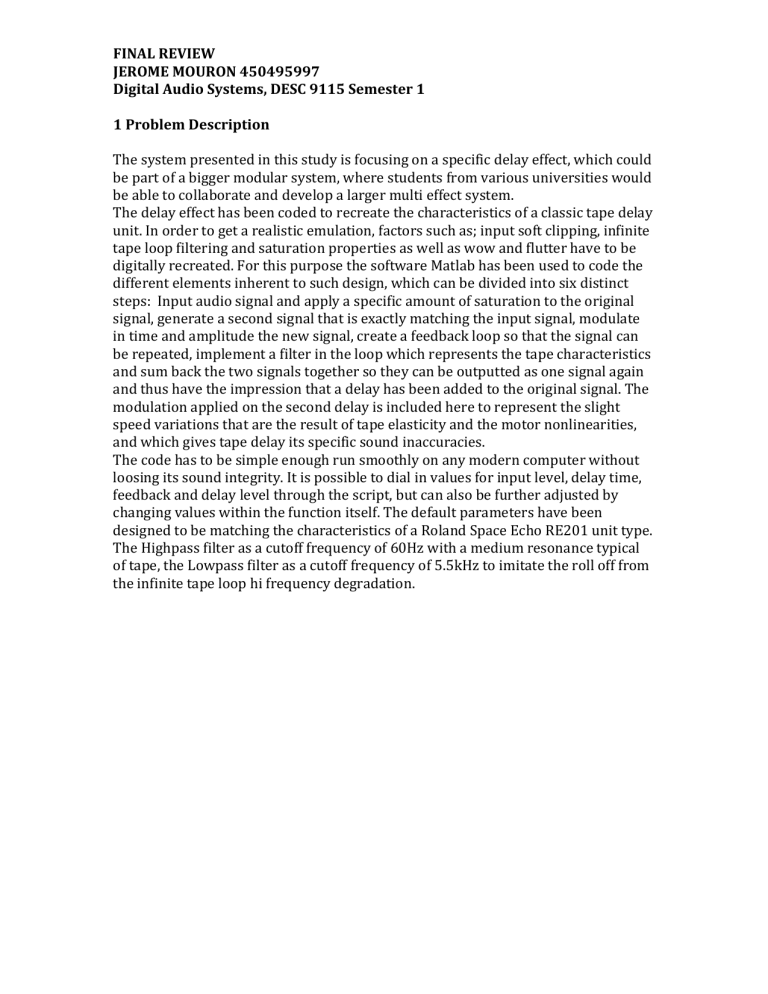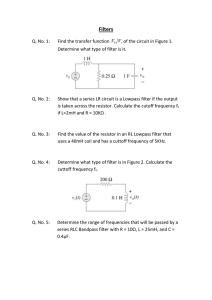
FINAL REVIEW JEROME MOURON 450495997 Digital Audio Systems, DESC 9115 Semester 1 1 Problem Description The system presented in this study is focusing on a specific delay effect, which could be part of a bigger modular system, where students from various universities would be able to collaborate and develop a larger multi effect system. The delay effect has been coded to recreate the characteristics of a classic tape delay unit. In order to get a realistic emulation, factors such as; input soft clipping, infinite tape loop filtering and saturation properties as well as wow and flutter have to be digitally recreated. For this purpose the software Matlab has been used to code the different elements inherent to such design, which can be divided into six distinct steps: Input audio signal and apply a specific amount of saturation to the original signal, generate a second signal that is exactly matching the input signal, modulate in time and amplitude the new signal, create a feedback loop so that the signal can be repeated, implement a filter in the loop which represents the tape characteristics and sum back the two signals together so they can be outputted as one signal again and thus have the impression that a delay has been added to the original signal. The modulation applied on the second delay is included here to represent the slight speed variations that are the result of tape elasticity and the motor nonlinearities, and which gives tape delay its specific sound inaccuracies. The code has to be simple enough run smoothly on any modern computer without loosing its sound integrity. It is possible to dial in values for input level, delay time, feedback and delay level through the script, but can also be further adjusted by changing values within the function itself. The default parameters have been designed to be matching the characteristics of a Roland Space Echo RE201 unit type. The Highpass filter as a cutoff frequency of 60Hz with a medium resonance typical of tape, the Lowpass filter as a cutoff frequency of 5.5kHz to imitate the roll off from the infinite tape loop hi frequency degradation. 2 Specification The algorithm is using a default sample rate of 44.1kHz but can be changed to any desired parameter to match the sample rate of the input signal. For this prototype the delay length used should not exceed 1.8 seconds in order to maintain stability. Signal Flow Representation INPUT SIGNAL Clean Soft Clip Hard Clip FeedForward Delay Sin Noise Shapped Modulator = + Delay Mod Noise Summing Feedback HP Filter LP Filter AllP Filter Summimg OUTPUT SIGNAL The gain-­‐dependent input state can either be clean (g<0.5), soft clipped (0.5<g<0.8) or hard clipped (g>0.8). This reflects the behaviour of the pre-­‐amplification stage as well as the tape saturation properties, which gives the delay a different timbre depending on the saturation applied. A delay is then generated and summed with a modulated one. The sinusoidal modulation used previously for the vibrato effect was too predictable and sounded unnatural so it is now combined with Gaussian noise, which creates a non-­‐linear modulation that matches better the properties inherent to tape. After summing, the signal goes into a feedback loop, which is filtered through a highpass, a lowpass and an allpass filter. While it is easy to understand the use of the highpass and lowpass filter -­‐ used to imitate frequency degradation over time from many repetitions -­‐ the allpass filter is being used to create a smearing effect by altering the signal phase. “A nonparametric allpass filter design method is presented for matching a desired group delay as a function of frequency. The technique is useful in physical modeling synthesis of musical instruments and emulation of audio effects devices exhibiting dispersive wave propagation”. (Proc. of the 9th Int. Conference on Digital Audio Effects (DAFx-­‐06), Montreal, Canada, September 18-­‐20, 2006 ROBUST DESIGN OF VERY HIGH-­‐ORDER ALLPASS DISPERSION FILTERS Jonathan S. Abel, Julius O. Smith). The delayed signal is then summed back with the original dry signal. 3 Implementation To achieve such a system I have used the original code designed by Guy Hopkins for his tape delay project, where I modified some of the parameters and added extra lines to match closely the desired effect. Input stage saturation -­‐Clean signal: if input signal is ≤ 0.5 then x(clean)=x. No processing is added to the input signal -­‐Symmetrical clipping: if input signal is 0.5≤ x ≤ 0.8 then x(sat)= symclip(x) Where symclip function is used to generate saturation and can be mathematically represented as follows: Source DAFX : digital audio effects / Udo Zolzer. – 2nd ed. The result of this process is a nonlinear soft saturation when 1/3 ≤ x ≤ 2/3, and a soft compression 2/3 ≤ x ≤ 1. -­‐Hard Clipping: if input signal is x ≥ 0.8 then x(clip) = Arctan (x) Where Arctan function or inverse tangent is used to generate hard clipping and can be mathematically expressed as follows: 𝑓 𝑥 = 𝑡𝑎𝑛 − 1(𝑧) = 𝑖2𝑙𝑜𝑔(𝑖 + 𝑧𝑖 − 𝑧) Clean Signal Soft Saturation Hard Clipping Delay Modulation Two delay lines had to be created to simulate the slight modulation of a tape delay. A simple variable length delay line was used in order to generate a time delay (addition of zeros to the input signal) and can be expressed as follows: y(n) = x (n − N) where N= number of samples used For the second modulated delay line the DAFX Vibrato code was used. The delay length is now modulated via an LFO. The width, gain and speed of the modulation were set according to the result that most closely resembled real tape delay. An extra Gaussian noise function was combined with the LFO to impart randomness and thus simulate nonlinear tape variations in a more faithful way. y(n) = x (n-­‐(N(mod x Gauss)) -­‐Feedback loop and filtering Inside the feedback loop the signal is going through three filtering steps: Highpass, Lowpass and Allpass. While the demonstration is simple for filters of the first order, it is quite elaborate to calculate higher order filters, which I used for this project. A simple demonstration will be preferred to illustrate the process with a first order filter for Highpass and Lowpass. The following equation represents the transfer function: Source DAFX : digital audio effects / Udo Zolzer. – 2nd ed. fc being the cutoff frequency and fs the sampling frequency Coefficients for first order filters A first order Allpass filter can be expressed as follows by the transfer function: Source DAFX : digital audio effects / Udo Zolzer. – 2nd ed. Summing The resulting fed back filtered signal is now summed with the fed forward input signal as the output signal. The previously added zeros for the delay are trimmed to match the size of the output signal. A .wav file is written. 4 Conclusion Thanks to the added distortion and filtering, the developed tape delay is not far from sounding like a real unit. The addition of a second feedback loop, which would allow the signal to go through a second Lowpass filter each time the delay repeats, would further enhance the result and would sound even closer to a real Space Echo. References -­‐(Proc. of the 9th Int. Conference on Digital Audio Effects (DAFx-­‐06), Montreal, Canada, September 18-­‐ 20, 2006 ROBUST DESIGN OF VERY HIGH-­‐ORDER ALLPASS DISPERSION FILTERS Jonathan S. Abel, Julius O. Smith). -­‐ DAFX : digital audio effects / Udo Zolzer. – 2nd edition.


